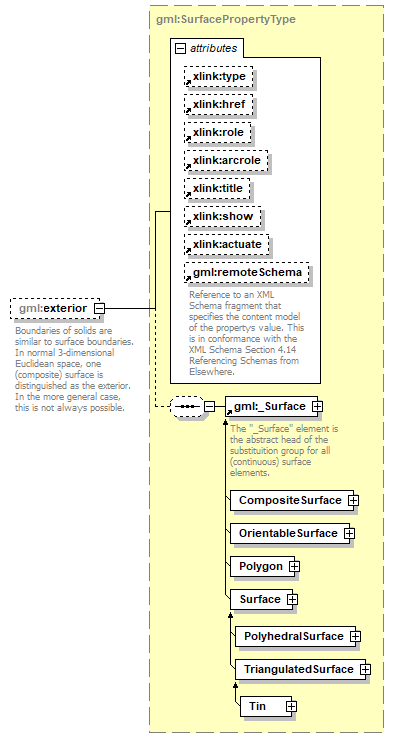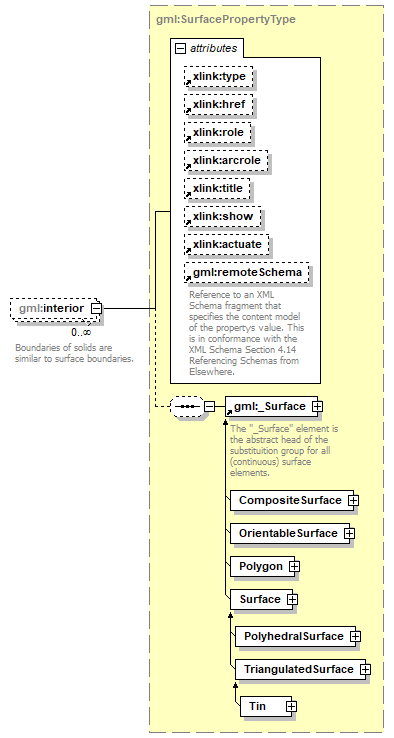| diagram |  |
||||||||||||||||||||||||||||||||||||||||||||||||||||||
| namespace | http://www.opengis.net/gml | ||||||||||||||||||||||||||||||||||||||||||||||||||||||
| type | extension of gml:AbstractSolidType | ||||||||||||||||||||||||||||||||||||||||||||||||||||||
| properties |
|
||||||||||||||||||||||||||||||||||||||||||||||||||||||
| children | gml:metaDataProperty gml:description gml:name gml:exterior gml:interior | ||||||||||||||||||||||||||||||||||||||||||||||||||||||
| used by |
|
||||||||||||||||||||||||||||||||||||||||||||||||||||||
| attributes |
|
||||||||||||||||||||||||||||||||||||||||||||||||||||||
| annotation |
|
||||||||||||||||||||||||||||||||||||||||||||||||||||||
| source | <xs:complexType name="SolidType"> <xs:annotation> <xs:documentation>A solid is the basis for 3-dimensional geometry. The extent of a solid is defined by the boundary surfaces (shells). A shell is represented by a composite surface, where every shell is used to represent a single connected component of the boundary of a solid. It consists of a composite surface (a list of orientable surfaces) connected in a topological cycle (an object whose boundary is empty). Unlike a Ring, a Shell's elements have no natural sort order. Like Rings, Shells are simple.</xs:documentation> </xs:annotation> <xs:complexContent> <xs:extension base="gml:AbstractSolidType"> <xs:sequence> <xs:element name="exterior" type="gml:SurfacePropertyType" minOccurs="0"> <xs:annotation> <xs:appinfo> <sch:pattern name="Check either href or content not both"> <sch:rule context="gml:exterior"> <sch:extends rule="hrefOrContent"/> </sch:rule> </sch:pattern> </xs:appinfo> <xs:documentation>Boundaries of solids are similar to surface boundaries. In normal 3-dimensional Euclidean space, one (composite) surface is distinguished as the exterior. In the more general case, this is not always possible.</xs:documentation> </xs:annotation> </xs:element> <xs:element name="interior" type="gml:SurfacePropertyType" minOccurs="0" maxOccurs="unbounded"> <xs:annotation> <xs:appinfo> <sch:pattern name="Check either href or content not both"> <sch:rule context="gml:interior"> <sch:extends rule="hrefOrContent"/> </sch:rule> </sch:pattern> </xs:appinfo> <xs:documentation>Boundaries of solids are similar to surface boundaries.</xs:documentation> </xs:annotation> </xs:element> </xs:sequence> </xs:extension> </xs:complexContent> </xs:complexType> |
element SolidType/exterior
| diagram |  |
||||||||||||||||||||||||||||||||||||||||||||||||||||||||
| namespace | http://www.opengis.net/gml | ||||||||||||||||||||||||||||||||||||||||||||||||||||||||
| type | gml:SurfacePropertyType | ||||||||||||||||||||||||||||||||||||||||||||||||||||||||
| properties |
|
||||||||||||||||||||||||||||||||||||||||||||||||||||||||
| children | gml:_Surface | ||||||||||||||||||||||||||||||||||||||||||||||||||||||||
| used by |
|
||||||||||||||||||||||||||||||||||||||||||||||||||||||||
| attributes |
|
||||||||||||||||||||||||||||||||||||||||||||||||||||||||
| annotation |
|
||||||||||||||||||||||||||||||||||||||||||||||||||||||||
| source | <xs:element name="exterior" type="gml:SurfacePropertyType" minOccurs="0"> <xs:annotation> <xs:appinfo> <sch:pattern name="Check either href or content not both"> <sch:rule context="gml:exterior"> <sch:extends rule="hrefOrContent"/> </sch:rule> </sch:pattern> </xs:appinfo> <xs:documentation>Boundaries of solids are similar to surface boundaries. In normal 3-dimensional Euclidean space, one (composite) surface is distinguished as the exterior. In the more general case, this is not always possible.</xs:documentation> </xs:annotation> </xs:element> |
element SolidType/interior
| diagram |  |
||||||||||||||||||||||||||||||||||||||||||||||||||||||||
| namespace | http://www.opengis.net/gml | ||||||||||||||||||||||||||||||||||||||||||||||||||||||||
| type | gml:SurfacePropertyType | ||||||||||||||||||||||||||||||||||||||||||||||||||||||||
| properties |
|
||||||||||||||||||||||||||||||||||||||||||||||||||||||||
| children | gml:_Surface | ||||||||||||||||||||||||||||||||||||||||||||||||||||||||
| used by |
|
||||||||||||||||||||||||||||||||||||||||||||||||||||||||
| attributes |
|
||||||||||||||||||||||||||||||||||||||||||||||||||||||||
| annotation |
|
||||||||||||||||||||||||||||||||||||||||||||||||||||||||
| source | <xs:element name="interior" type="gml:SurfacePropertyType" minOccurs="0" maxOccurs="unbounded"> <xs:annotation> <xs:appinfo> <sch:pattern name="Check either href or content not both"> <sch:rule context="gml:interior"> <sch:extends rule="hrefOrContent"/> </sch:rule> </sch:pattern> </xs:appinfo> <xs:documentation>Boundaries of solids are similar to surface boundaries.</xs:documentation> </xs:annotation> </xs:element> |
XML Schema documentation generated by XMLSpy Schema Editor http://www.altova.com/xmlspy